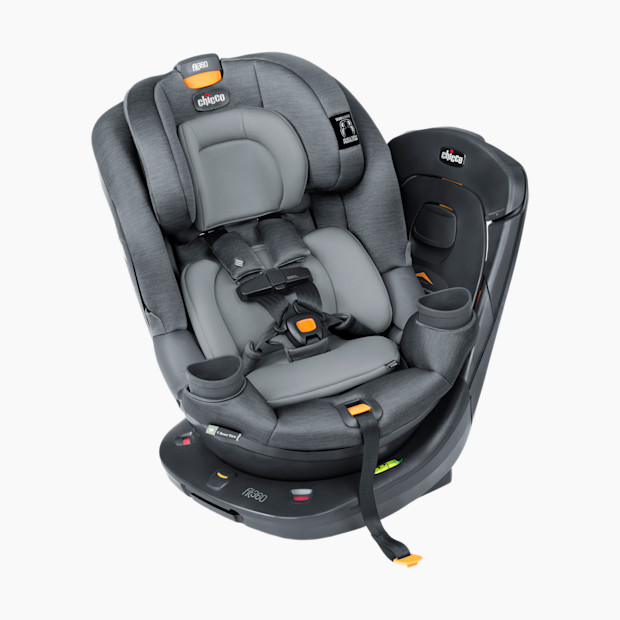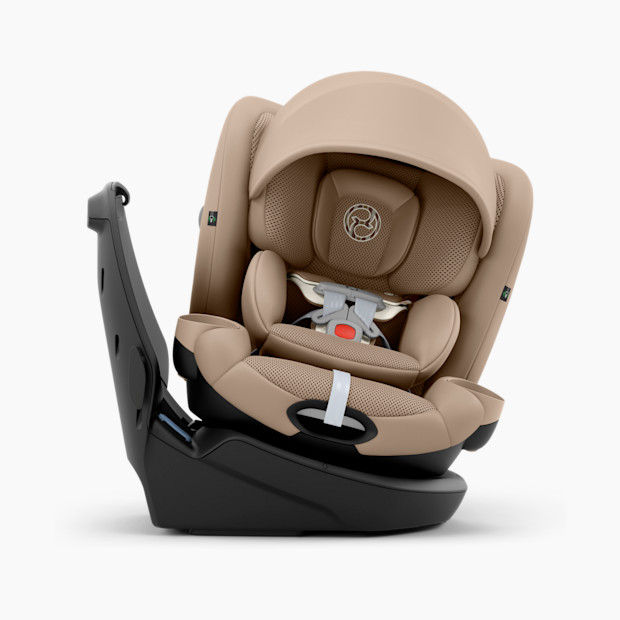
Are Rotating Car Seats Safe? What to Know About These Innovative Seats
Rotating car seats make getting your little one in and out easier—but are they safe? Two car seat experts weigh in.

In This Article
If you’ve ever tried to wrangle a less-than-cooperative toddler into a rear-facing car seat, you know just what an ordeal it can be. That’s why so many parents have decided to give rotating car seats a try. Popular in Europe but newer to the US market over the last few years, these convertible seats spin at the base, making getting your little one in and out of the car easier.
As a Child Passenger Safety Technician (a CPST, someone who's trained in car seat education and usage), I've heard some parents express doubts about this new style of seat. Do rotating car seats offer the same protection as the safest convertible car seats? Since the seat rotates, is there a risk of it detaching in a crash? Do rotating car seats have to pass the same safety standards as non-rotating seats? And if these types of seats have been popular in Europe for years, what took so long for them to make their way to the United States?
We sat down with a leader in car seat safety, Dr. Alisa Baer, a pediatrician, CPST and the co-founder of The Car Seat Lady, for a deep dive into rotating car seats.
What Is a Rotating Car Seat?
A rotating car seat is similar to a traditional convertible car seat with the addition of one innovative feature: rotation. Sometimes also called swiveling car seats, rotating car seats spin on their base either 180 or a full 360 degrees. They have many of the same features you’d find in a traditional seat, such as the ability to rear- or forward-face, a five-point harness, variable recline positions and LATCH, with the added bonus of a swiveling seat.
Most parents choose a rotating car seat for two main reasons: ease and safety. Rotating seats eliminate the awkward reach that’s needed with standard rear-facing seats, making it easier to get your baby or toddler in and out of the car. They can also encourage independence as your baby grows into a toddler. “Depending on the particular seat, it may be easier for a child to climb in and out independently when using a seat that is rotated,” says Dr. Baer.
Rotating car seats can also be beneficial to individuals with physical limitations. “Parents and caregivers with certain physical disabilities might be able to take a child independently in a car using one of these seats but would be unable to do so with a non-rotating car seat,” says Dr. Baer.
This ease of use also means you may be more likely to rear-face your little one longer if you’re using a rotating car seat—and with a growing body of research supporting riding rear-facing as the safest option for babies and children, a rotating car seat can be a good option to ensure you’re maxing out the rear-facing weight or height limits of your car seat.
“In vehicles with captain’s chairs in the second row, rear-facing convertible seats typically block access to the center aisle and thus block third-row access, which often prompts parents to turn kids forward-facing too soon in order to preserve that access,” shares Dr. Baer. “A rotating seat may allow for access to the center aisle and thereby encourage a parent to keep the child in the second row rear-facing longer.”
Rotating Car Seats in the US
If you’ve ever traveled to Europe or know a parent of a young child who has lived abroad, you may know that rotating car seats have been a popular car seat choice for European parents for quite a while. So why did it take so long for these types of seats to make their way to the US?
It’s all in the details of the regulations, explains Dr. Baer. Europe’s car seat regulations differ quite a bit from those in the US, making it much easier to design a rotating car seat for the European market than the US market.
“In Europe, they allow car seats to have just one installation method, such as just LATCH or just seat belt, whereas in the US, all car seats must have two installation methods—one with LATCH and one with the vehicle’s seat belt,” she says. (LATCH stands for Lower Anchors and Tethers for Children and is a system for securing a car seat to a vehicle using straps or connectors on the car seat that attach to fixed metal anchors in a vehicle.)
The type of LATCH most commonly used in each geographic area plays a part, too. “In Europe, car seats typically use rigid LATCH, whereas in the US, nearly every car seat uses a LATCH strap,” explains Dr. Baer. “When you don’t need to accommodate a strap passing through the car seat in a spot right near where the rotating mechanism is, it is much easier to have a rotating mechanism that doesn’t interfere with installation—or where installation doesn’t interfere with rotation.”
Rotating Car Seats + Safety: What You Need to Know
For most parents, safety is the paramount concern when shopping for a car seat for their child. And every car seat sold in the US must meet the same federal safety standards—including rotating car seats. But there is a bit of nuance here that’s worth understanding.
“Since car seat manufacturers in the US are not required to release their crash test results, all we can say about any car seat is that a seat passes the US government’s mandated crash tests,” says Dr. Baer. “If the seat fails the test, it won’t be on the market.”
So what does that mean for you as the consumer who’s weighing a rotating car seat against a traditional one, or is set on a rotating seat but trying to decide between different brands and models? Dr. Baer recommends keeping these points in mind when shopping:
Pay attention to the seat’s construction. Some rotating car seats consist of two separate pieces: a base and a shell. Any time you have two separate parts, there’s a potential for them to separate in the event of a crash. This is not supposed to happen, but the possibility is there, and it’s something to consider as you make your decision.
Internal seat construction is important, too. Don’t forget about the seat’s internal construction. Just like infant car seats with a base, rotating car seats use different mechanisms to connect the shell to the base. Some are likely more secure than others (metal-to-metal connections, for example, rather than plastic connections).
Keep human error in mind. There’s always room for human error when installing and using even the safest baby car seat, and rotating car seats are no different. Look for a rotating seat that aims to minimize this as much as possible. Is there an easy-to-read indicator that shows the seat is locked into position (e.g., a button that turns from red to green)? What about a similar feature that helps you know the seat is properly connected to the base? According to Dr. Baer, features like these can help minimize car seat installation mistakes and maximize the chance that you’re using your rotating car seat correctly.
Rotating Car Seat Safety Tips
“Parents and caregivers make many of the same mistakes with rotating car seats as they do with non-rotating ones: a seat that’s installed too loosely, not using the tether forward-facing, not buckling a child in tightly enough or transitioning a child from rear- to forward-facing too soon,” says Dr. Baer. But she says there are a few specific safety tips you should keep in mind if you’re using a rotating car seat.
Use the sideways-facing position of a rotating car seat for loading and unloading your child and only do so when the car is not in motion. Never ride with a child facing sideways in a rotating car seat.
Two-piece rotating car seats (base + shell) are designed to be used together. Never use the shell as a standalone car seat without the base.
Always be sure the car seat is locked in place (either forward- or rear-facing, depending on how you’re using the seat) before your car ride begins.
Unlike traditional car seats that need to be uninstalled and reinstalled when it’s time to make the rear- to forward-facing switch, many rotating car seats make this easy. But there are a few things to keep in mind:
Some rotating car seats require you to uninstall and reinstall the seat differently when making the rear-to-forward-facing switch. Always read your car seat manual and follow the manufacturer's specific installation instructions.
When a child is riding rear-facing, the car seat's harness straps should sit at or just below the child's shoulders. When forward-facing, the straps should sit at or just above the shoulders. Be sure to follow these guidelines when you make the switch.
Don't turn your child forward-facing too soon, Dr. Baer cautions. Instead, max out the rear-facing height or weight limits of any car seat, including rotating seats.
Expert Sources
Babylist content uses high-quality subject matter experts to provide accurate and reliable information to our users. Sources for this story include:
Dr. Alisa Baer is a pediatrician, a Child Passenger Safety Technician and the co-founder of The Car Seat Lady






